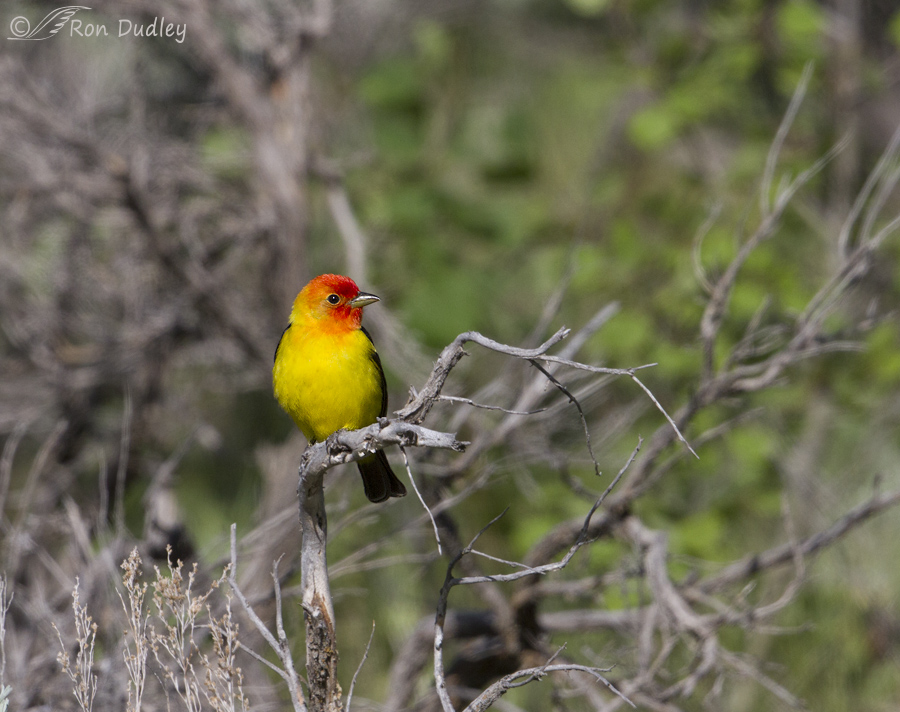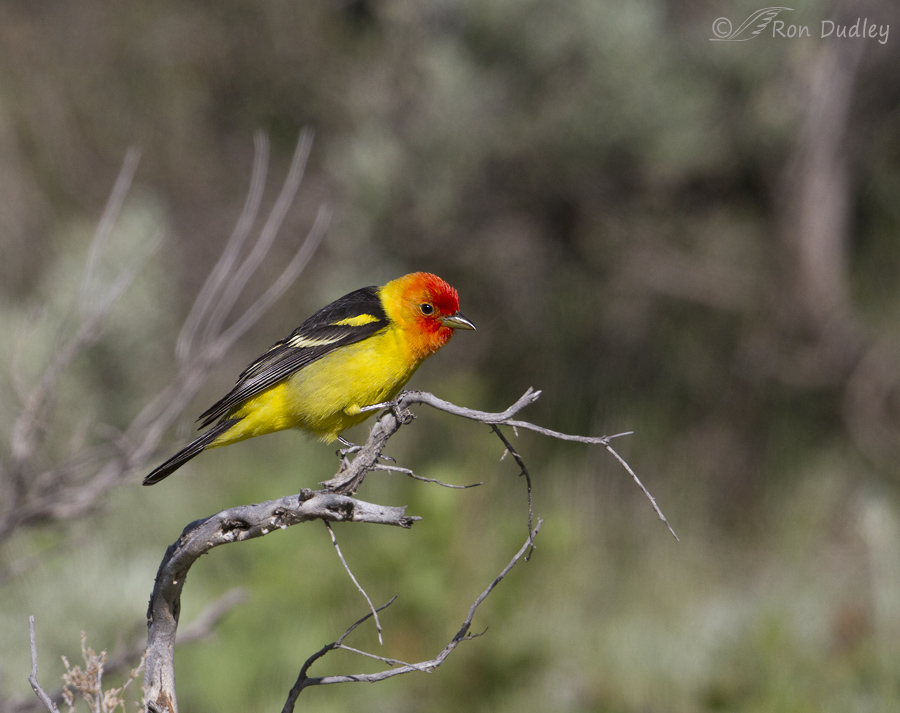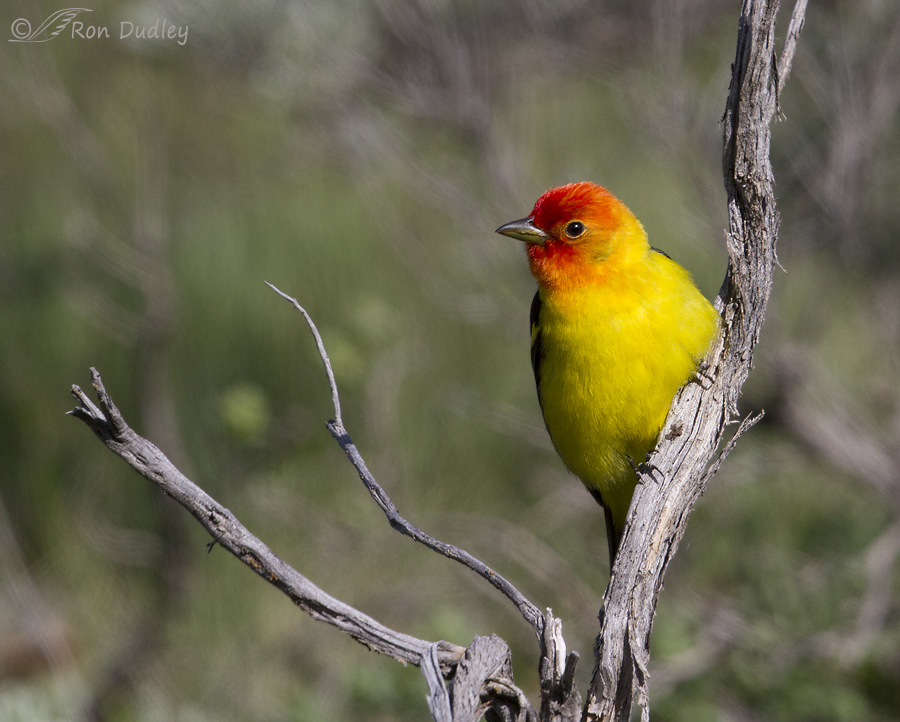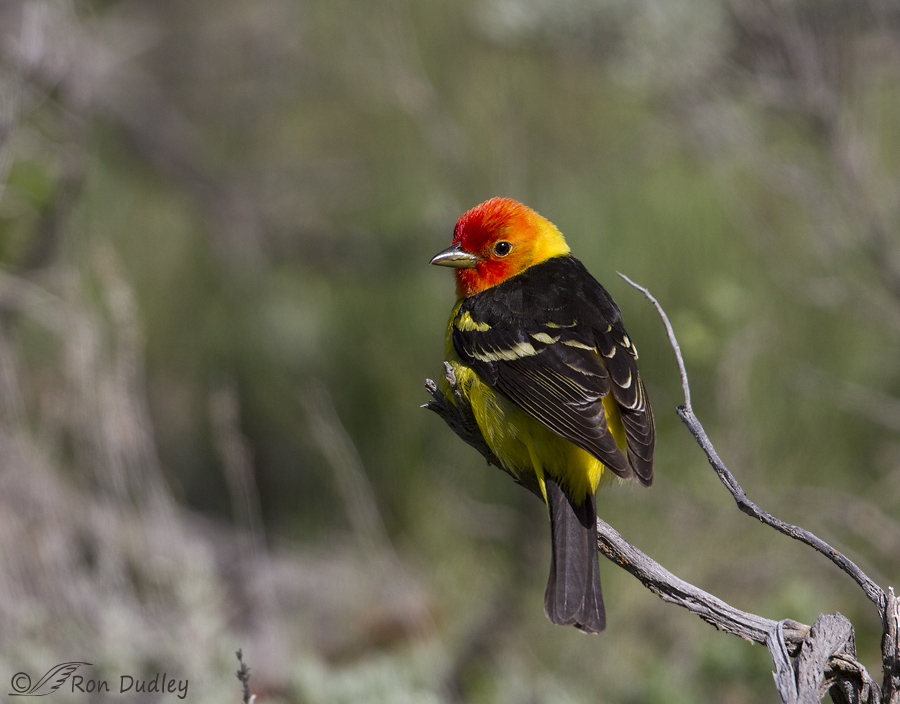Without a doubt the most colorful bird I photographed on our camping trip last week was the male Western Tanager.

1/2500, f/7.1, ISO 500, Canon 7D, Canon EF500mm f/4L IS II USM +1.4tc, not baited, set up or called in
This species usually prefers the cover of shade so I was excited to catch him out in the open along a dirt road near the border of Montana and Idaho. I snapped off these first two shots from quite a distance because I feared he’d fly off as I approached in my pickup.

1/3200, f/6.3, ISO 500, Canon 7D, Canon EF500mm f/4L IS II USM +1.4tc, not baited, set up or called in
I was pleased that he gave me a side view on that gnarly old perch but he was still too far away for good detail.

1/3200, f/6.3, ISO 500, Canon 7D, Canon EF500mm f/4L IS II USM +1.4tc, not baited, set up or called in
He flew to a nearby perch and allowed me to get significantly closer. I feared that our presence might be making him nervous but I needn’t have worried because he eye-balled the larger twig at left…

1/2500, f/6.3, ISO 500, Canon 7D, Canon EF500mm f/4L IS II USM +1.4tc, not baited, set up or called in
and promptly hopped onto it and plopped down for a brief rest, only occasionally looking back to check us out. Eventually he flew off after allowing me some reasonably close shots. In this image the bird is slightly centered in the frame but I wanted to “anchor” the branch that wraps over his back which required cropping this way.
I’m always struck by the reds on the head of the male Western Tanager which look to me like he’s dipped his face into a bucket of red paint. The red comes from the plumage pigment rhodaxanthin which is a rare pigment in birds. The red pigments (4-oxo-carotenoids) in other tanager species are produced metabolically from yellow pigments but these Western Tanager red pigments are obtained directly from their diet, presumably from insects.
Ron


Superb photographs! Once again, your skill and patience pays off, Ron. And once again your post generated some really interesting and educational responses. How wonderfully complex biology can be!
I could not believe your luck with the second photo, and your good eye, how the branches framed this fellow’s body without merging with it. Lovely photos and great perch. Gorgeous bird and you have captured how brilliant he really is.I have seen one here but not for a few years.
Beautiful bird and lovely setting. Interesting info about the pigments. Bookmarking this page for future reference.
Re: composition–make that all three …they’re ALL great!!!
The composition on the last frame is PERFECT!!!
Do you think that rather than some dietary explanation, that incredibly beautiful little bird may have flown too close to either the sunrise or the sunset…or both…or… through a rainbow???
Very interesting about the pigments. I wonder if the insects they get it from would be cochineal, the mealy bug from which Native Americans obtained a red dye? As usual, this is a beautiful series of photos, and I love the way you are able to capture the personality of the bird you are photographing.
Interesting question, Susan. Wish I knew…
Given what Dan said, I doubt that those scale insects (not mealy bugs, as I had thought) would be the source, unless there is more than one source for that pigment, because the only thing they eat is prickly pears or other plants in the genus Opuntia. I hadn’t read his comment when I made mine. It is, however, interesting to speculate on whether or not a bird could get pigment from eating those insects.
Susan Stone asked about cochineal. As she later indicates, these are not the insects eaten by the tanagers. Cochineal are scale insects native to Central and South America and the females produce a bright red pigment (cochineal, from which the insect gets its name). Carmine, another red dye, is also derived from cochineal. These insects are basically a parasite on some particular kinds of cacti. Rhodoxanthin, however, is an entirely different chemical produced by some conifers, not insects. It is rarely found in birds. Aside from Western Tanager, it has been found in at least one pigeon, a couple species of manikins, and some cotingas. There is also a species of European honeysuckle that produces rhodoxanthin. This plant has been introduced in parts of the mid-west and Cedar Waxwings feed the berries of this plant to their young. The rhodoxanthin then causes the tip of the tails to be orange instead of yellow as the feathers develop in these young waxwings. By the time these young waxwings are ready to molt, the berries are no longer available so there tails will be the normal yellow. (Remember that pigments can only get into the feathers when the feathers are developing and growing. Deposition of pigment into the feather is under genetic control.)
Western Tanagers would seldom come into contact with cochineal insects, even though the winter range of Western Tanager is Central America (southern Mexico to Costa Rica). The tanagers are found mostly in the highland forests whereas the cacti are in dry lowlands.
Fun stuff!
Dan Gleason
Oh my. Education and delight again. Thank you. I had never known about the colours of plumage being derived from diet (other than flamingoes) and will have to do some investigation to see if it is also true of our crimson rosellas for example. Thank you Ron – and Dan.
Thanks to folks like Dan I’m learning things here too, Elephant’s Child. That’s one of the reasons I blog…
Hi Ron,
Beautiful photos, as always. Color in birds is a fascinating topic. Bright red, orange and yellow are all derived from plant pigments in the diet. The rhodaxanthin is a pigment produced by the needles of many conifers. The needles are eaten by insects which are in turn eaten by the tanagers who spend much of their breeding time in coniferous trees. Western Tanagers have apparently lost the ability to modify the carotenoids used by other tanagers of the genus Piranga. There may be an advantage to using pigments directly rather than needing to metabolically convert other kinds of pigments. Some of the coloration on the male’s head is further modified to a slight golden hue (this is a bit subtle) by the addition of varying amounts of phaeomelanin. Phaeomelanin is one of two forms of melanin produced by most birds and causes some of the rusty reds (Red-tailed Hawk, Spotted Towhee) found in many birds. (The other form of melanin is eumelanin which causes mostly blacks and grays.)
Dan Gleason
That’s fascinating information, Dan. Thank you. I’ve read it very carefully, twice. Probably will again…
Such a beautiful little creature! Great photos as usual Ron! My daughter has begun birding the past year & with her travels (now in Middle East again) she’s really enjoyed seeing the birds in that area. 😎
Great to hear of the “next generation” developing an interest in birds, Annie. Thank you.
My favorite bird to photograph! You got some gorgeous shots! I love see your fine photography!
I appreciate the compliment, Jane.
What gorgeous sensational shots Ron! Thanks so much for sharing!
Charlotte
Thanks, Charlotte.
Absolute perfection!I think these are my favorite photos ever. Not just because it is such a beautiful bird but because the Western Tanager is what led me to my love of birds. It will forever hold a very prominent place in my heart.
Sounds like there’s a story there, Marya. Thank you.
Yes, a beautiful, spiritual and life-changing story. Which I really need to write up someday and share with others.
If anyone reading your post can’t figure out to stay in their vehicle and use it as a blind, they have to have a few cells missing!! Fantastic shots Ron! Even at a distance the clarity is excellent! What a wonderful surprise you had, and I bet the adrenaline was rushing during this episode.
If I’d have been on foot the bird would certainly have vamoosed, Dick. And you’re right, it was an adrenalin rush.
Oh so gorgeous! I have never seen any in real, but your photos are the best one I have seen. Thank you for sharing!
Thanks very much, Rima.
Wow! Gorgeous shots! Thanks for the great info about the origin of the pigments.
I’m glad you appreciated that info, Sharon. Thanks.
So lucky to see this beauty and capture your wonder shots. I have never seen any tanager. My hands would probably be shaking to much to capture anything!!! Just beautiful Ron.
Ellen, My hands shake a bit normally (familial tremors) so when I get “buck fever” from an exciting photo opportunity the problem is exacerbated. That’s one of the reasons I don’t shoot hand-held very often. Thank you.
oh my goodness … what a beauty he is, Ron!!!!
Yes he is, isn’t he, Lois!
What a beauty! As a girl, I heard a scarlet tanager and finally saw it after much stalking. So pretty. That was in Louisiana.
I’ve never seen a Scarlet Tanager and probably never will, Arwen.
I find it interesting that the reds on the Scarlet are from a different pigment than those of the Western – one that must be produced metabolically rather than obtained directly from the diet as it is in the Western. Perhaps that explains the difference in the shades of red in the two species – the Western is an orange-red and the Scarlet is… well, scarlet.
This one was a male (I guess because he was very intensely colored) and finally emerged from the woods to perch for a bit on a pole. I was very excited to see him. My uncle got me interested in birding way back in the day. 😀 He could probably tell us why the color is different. Might be due to the environment in terms of how they hide? I’m so loving your site. Thank you for sharing your work so generously here. I posted a link to your blog recently (not the pictures!) because I wanted others to see this.
Thank you for posting the link and not the images, Arwen.
I don’t know how you did it but this bird shows absolutely no fear. And that look on the last photo, so calm and trustful.
Wonderful shots. You made my day.
Thank you for sharing.
And your typically thoughtful comments make my day, Jorge. Thank you.